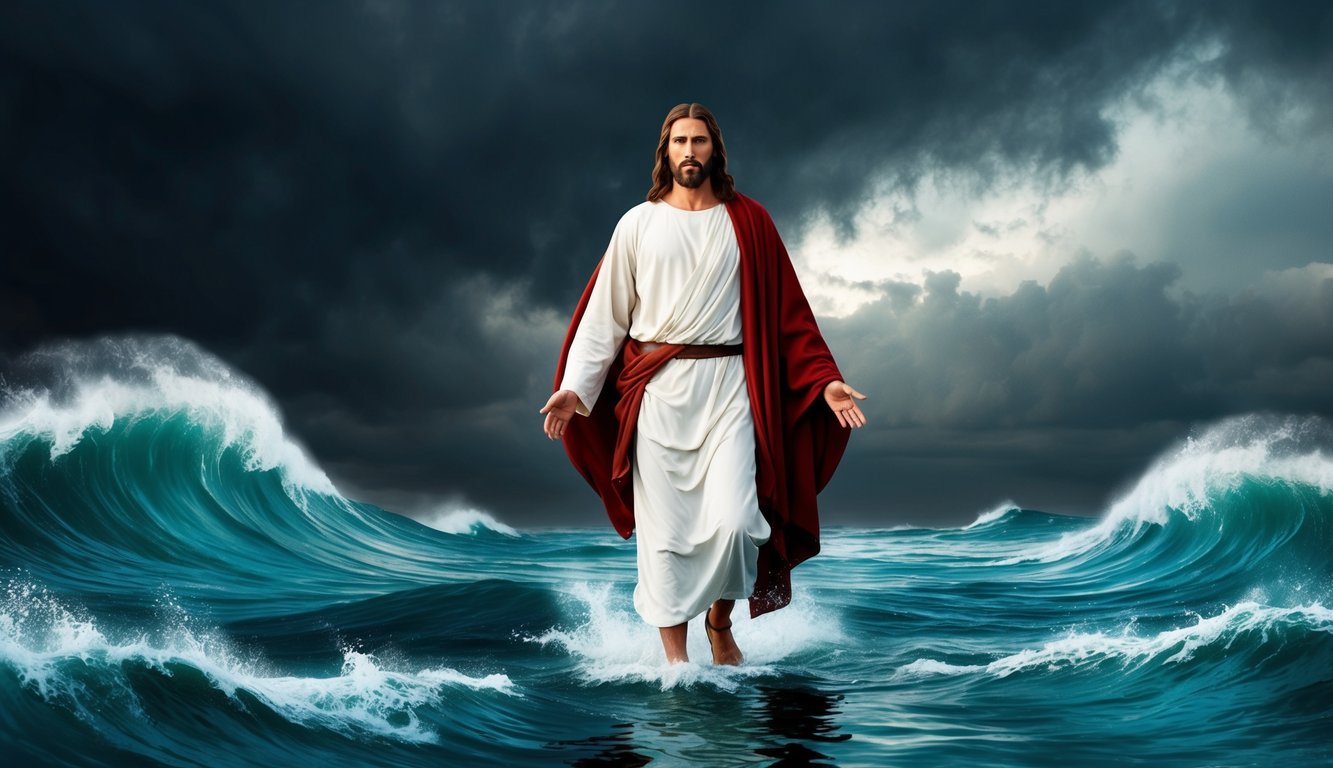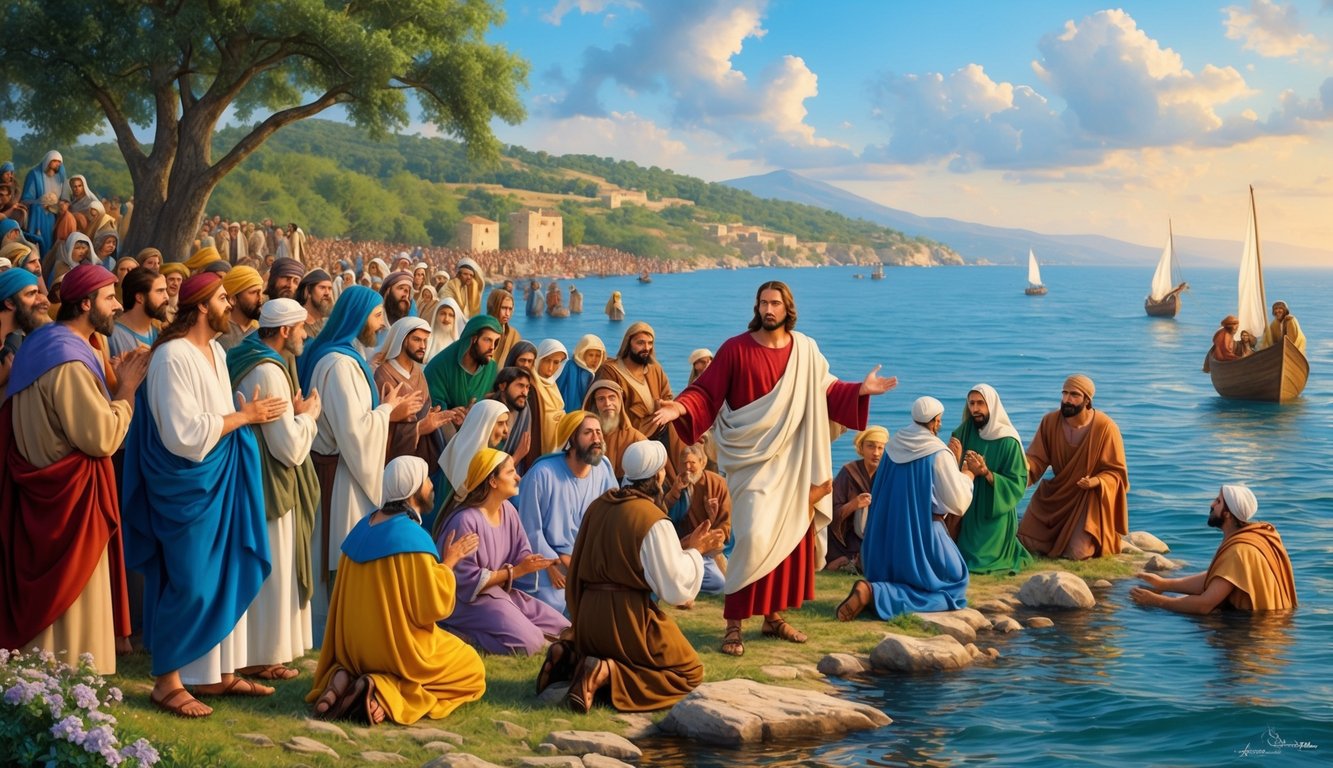Don’t Miss Out On This Unique Astrological Opportunity
Are you tired of spinning your wheels and getting nowhere? Simply put, you’re out of sync: you’re out of alignment with your astral configuration.
But: there’s a kind of map that can help you reclaim your alignment. Think of it as your own personal blueprint to success and happiness: a blueprint that will help you live your most amazing life.
Get started here.
Matthew 14 offers a deep dive into some of the most compelling stories in the New Testament. It begins with the tragic account of John the Baptist, who loses his life due to the whims of a vengeful queen. This sets a foreboding tone but also emphasizes the stark realities faced during those times.
The chapter continues with one of Jesus’s most famous miracles: feeding the five thousand.
This event shows Jesus’s ability to provide and highlights the importance of faith.
His compassion and power bring hope to a large crowd with just five loaves and two fish.
The significance of such acts has made this story a cornerstone of lessons in faith and abundance.
Following that, the chapter narrates how Jesus walks on water, an event that starkly illustrates his divine nature.
It’s a moment that tests the faith of his disciples and invites you to reflect on belief even in tumultuous times.
As you engage with Matthew 14, you’ll encounter a series of events that challenge, inspire, and direct the faithful.
Key Takeaways
- John the Baptist faced a tragic end.
- Jesus fed five thousand with a small meal.
- Walking on water showcased faith.
The Tragic End of John the Baptist
The tragic fate of John the Baptist is intertwined with the dynamics of Herod’s court.
His execution was a result of complex relationships and rash promises made by Herod, influenced by Herodias and her daughter.
Herod’s Birthday Feast and Oath
Herod hosted a grand birthday feast, and the atmosphere was charged with celebration.
During the festivities, the daughter of Herodias danced, captivating Herod and his guests.
Pleased with her performance, Herod made a bold promise.
In front of his guests, he took an oath, promising to give her whatever she wished.
Herodias, seizing the opportunity, prompted her daughter to ask for John the Baptist’s head.
This oath, made in a moment of excitement and in front of many witnesses, put Herod in a difficult position.
John’s Martyrdom
John the Baptist was imprisoned by Herod due to his direct criticisms of Herod’s marriage to Herodias, which he deemed unlawful.
After the oath, Herod was hesitant but felt compelled to carry out the request.
Despite recognizing John as a righteous man and a prophet, he valued his reputation and the promise he made more.
Reluctantly, Herod ordered John’s beheading.
John’s death was not just the end of a courageous voice, but a pivotal moment that resonated deeply, illustrating the dangers of vanity and unwise promises.
John’s Disciples Bury Him
After the execution, John’s disciples took action.
They retrieved his body and buried it respectfully.
This act was significant as it displayed their loyalty and respect for their teacher.
In a time of fear and uncertainty, the disciples remained steadfast.
They then went to inform Jesus about what had occurred.
This moment was a turning point that solidified the legacy of John the Baptist’s unwavering stance on righteousness and paved the way for Jesus’ ministry.
Feeding the Five Thousand
In Matthew 14, the story of the feeding of the five thousand is both a display of compassion and a demonstration of miraculous powers.
The event highlights how Jesus used five loaves and two fish to satisfy a large crowd, leaving twelve baskets of leftovers.
The Miracle of Multiplication
When you read about the miracle of multiplication, you’ll see how Jesus took a small amount of food—five loaves and two fish—and turned it into a feast for thousands.
He showed compassion for the hungry crowd, which included men, women, and children.
Before the miracle, the crowds had gathered from nearby villages to receive healing for the sick and to hear Jesus speak.
By performing this miracle, Jesus blessed the loaves and fish, demonstrating his ability to provide abundantly.
Everyone ate and was satisfied.
This act of feeding illustrates not only a physical, but also a spiritual nourishment for those present.
The miraculous multiplication reassured the people of Jesus’ divine power and served as a symbol of his caring nature.
The Significance of Twelve Baskets
After everyone was fed, something remarkable happened—the leftover, broken pieces filled twelve baskets.
This detail underscores the abundance that resulted from the miracle.
For you, the number twelve might symbolize completeness or the twelve tribes of Israel, showing the inclusiveness of Jesus’ ministry.
The twelve baskets also highlight how nothing was wasted, teaching a lesson about gratitude and stewardship.
This act of collecting leftovers ensured that food was available beyond the immediate need, perhaps hinting at the ongoing provision and care Jesus offers to all.
The abundance from a mere few loaves and fish underscores the extent of Jesus’ provision and his role as a provider.
Jesus Walks on the Water

In Matthew 14, the story of Jesus walking on the water highlights themes of faith, doubt, and courage.
Key moments include the disciples’ fear during a storm, Peter’s struggle with faith, and Jesus’ ability to calm the storm.
The Disciples’ Fear at Sea
You find the disciples in a boat, battling strong waves and fierce winds during the fourth watch of the night.
This was a time when fear was common because of the unpredictable seas.
As they struggled, they saw Jesus walking on the water.
At first, they thought He was a ghost, which added to their fear and panic.
Their fright was about more than the storm.
It reflected their limited faith and understanding of Jesus’ divine nature.
The sight of Jesus on the water was unexpected, but His appearance offered a lesson about faith in the midst of chaos.
Peter’s Moment of Doubt
When Peter saw Jesus, he wanted to test his faith.
He asked Jesus to call him onto the water.
As Peter stepped out of the boat, he began to walk towards Jesus.
Initially confident, Peter became distracted by the strong wind and towering waves.
His focus shifted from Jesus to the storm around him.
This moment of doubt caused him to start sinking.
You can see Peter’s faith wavering, revealing what Jesus later described as “little faith.” As Peter began to sink, he cried out to Jesus for help, showcasing how human doubts can impact faith.
Jesus Calms the Storm
Jesus reached out and took Peter’s hand, pulling him to safety.
He gently questioned Peter, pointing out his lack of faith.
His action reassured not just Peter, but all the disciples in the boat.
Jesus’ power over nature calmed the storm and quieted their fears.
In this moment, the disciples worshiped Jesus, acknowledging Him as the Son of God.
His ability to calm the wind and waves demonstrated His divine authority.
Through this event, you see an example of faith tested and purified by trials, with the disciples’ fear turned to awe and worship.
Healing in Gennesaret

In the area of Gennesaret, people flocked to see Jesus due to his miraculous powers.
The multitude sought healing, flocking to him with unwavering faith.
The stories emphasize the healing that occurred through simple acts of faith, such as touching the edge of his cloak.
The Power of Faith in Healing
The healing that took place in Gennesaret strongly reflects the power of faith.
Many believed that merely touching Jesus’ cloak could bring about miraculous cures.
This belief was not misplaced; those who reached out were healed from their ailments.
It showcases how faith served as a catalyst for these divine acts.
Touched by faith, people found themselves freed from sickness.
The cloak of Jesus became a symbol of hope and healing.
The faithful believed in the profound power that rested even at the edge of his garment.
This act of reaching out, a simple touch, serves as a testament to the blessings that can arise from deep-seated belief.
The Crowds Seek Jesus
In Gennesaret, word about Jesus spread rapidly among the people.
Crowds from various areas gathered in hopes of witnessing or experiencing his miraculous healing powers.
The multitude’s determination to find Jesus was evident as they traveled from their own homes and villages to seek him.
The sick were brought to him, and people laid them in the streets, hoping they could receive healing even through the briefest contact.
The scene in Gennesaret illustrated a community in search of salvation, relying on Jesus’ miraculous abilities.
The sheer number of people and their eagerness to witness his ministry speaks volumes about his impact and the hope he inspired.
Frequently Asked Questions

Matthew 14 covers several important events, such as Jesus feeding a multitude and walking on water.
These stories highlight Jesus’ compassion, power, and authority.
Scholars often explore the significance of these events in understanding Jesus’ teachings and the symbolism within the narrative.
What is the main message of Matthew chapter 14?
Matthew chapter 14 focuses on key events that demonstrate Jesus’ divine power and compassion.
This chapter includes the story of feeding thousands and walking on water, showcasing both his ability to perform miracles and his care for people.
Who did Jesus feed in Matthew 14, and what is the significance of this event?
In Matthew 14, Jesus feeds around 5,000 men, not counting women and children.
This miracle highlights Jesus’ ability to provide abundantly, even in scarce situations.
It is symbolic of God’s provision and foreshadows the spiritual nourishment Jesus offers through teachings.
What are the key miracles performed by Jesus in Matthew 14?
Matthew 14 describes two key miracles: feeding the 5,000 and walking on water.
The feeding miracle shows Jesus’ power to multiply resources, while walking on water illustrates his command over the natural world.
Both miracles emphasize his divine strength and presence.
How does Matthew 14:22-33 illustrate Jesus’ power over nature?
In Matthew 14:22-33, Jesus walks on water, demonstrating his authority over nature.
This event reassures the disciples of Jesus’ divine nature and calms their fears during a storm.
It also emphasizes faith, as Peter briefly joins Jesus on the water before doubting.
In what ways is the number “14” particularly significant in the Gospel of Matthew?
The number “14” holds symbolic importance in Matthew’s Gospel due to its association with genealogy.
In Matthew 1, Jesus’ ancestry is grouped into three sets of fourteen generations.
This structure underscores Jesus’ connection to significant biblical figures and strengthens his messianic claim.
What lessons can be drawn from the events of Matthew 14 according to biblical scholars?
Scholars suggest several lessons from Matthew 14.
One lesson is the importance of faith, as we see in Peter’s experience on the water.
Another lesson is trust in divine provision, as shown by the feeding of the 5,000.
These stories reinforce the themes of belief and reliance on Jesus.
Additionally, these lessons connect to the Matthew 13 parables, which emphasize the kingdom of heaven and the power of faith.
Just as Jesus taught through parables about spiritual growth, His actions in Matthew 14 demonstrate His authority and care for His followers.
Both chapters highlight the significance of trusting in God’s provision and deepening one’s faith.



